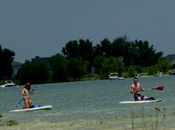Stand Up Paddle Boarding (SUP)
There are plenty of reasons to give stand up paddle boarding a try, from the sport’s ease of entry to the amazing 360° views from the water. Once you’re sold on trying it out, follow these steps for a smooth first experience!
First, rent a board. Since good boards run at least $800-$1100, it’s best to rent first before diving into the financial commitment. Some of our state parks feature vendors on site, so you can snag a board right on the lake! Vendors can also offer great first-time tips and answer any questions you’ve got.
Renting will most likely cost somewhere around $25 per hour, with half and full day rates available too. In most cases, the rental includes all the equipment you’ll need: board, paddle, whistle and personal flotation device. There must be one PFD on board per individual.
Boards are bigger and heavier than you might expect! Be careful not to let the board drag as you carry it to the water.
Once you’ve got your rental and brought your board to the water’s edge, you’re ready to go for it!
Wade out into the water if you're launching from a beach. Pull your board next to you until you are at least knee deep in the water. This way, you won’t damage the blade by putting your weight on the board before the water is deep enough.
 Start out on your knees. Most boards have a handle or hole in the true center, and this is where you should center your weight. Paddle for a while, learn how the board moves and how wakes feel, and get your balance from this position.
Start out on your knees. Most boards have a handle or hole in the true center, and this is where you should center your weight. Paddle for a while, learn how the board moves and how wakes feel, and get your balance from this position.
Get up, stand up! Keep your weight at the board’s center, and keep your feet a bit wider than shoulder width apart. This will make balancing easier. If you want a more intense core workout, test your balance by moving your feet closer together.
Paddle! The sooner you propel yourself forward and get some smooth movement going, the easier it will be to gain some stability on the board. Your paddle should be about long enough to come to your palm if you stand with your arm straight up. One hand goes over the top handle of the paddle, while the other is farther down the shaft. Try to get as much of the paddle in the water as possible - this is your motor!
Make turns. Stroke forward to backward on each side depending on  the direction you want to go; this probably won’t mean alternating evenly, as you’ll have to accommodate for the water’s movement as well as wind and wakes. Paddle on the opposite side of which direction you want to turn, and turn your torso toward the direction you’re turning. Bending your knees helps, too.
the direction you want to go; this probably won’t mean alternating evenly, as you’ll have to accommodate for the water’s movement as well as wind and wakes. Paddle on the opposite side of which direction you want to turn, and turn your torso toward the direction you’re turning. Bending your knees helps, too.
Take it all in. Stand up paddle boarding offers a view like none other; if the water is clear, peer downward to see aquatic wildlife. Gaze out over the sparkling water and enjoy the singular feeling of floating on your own two feet - standing on water.

